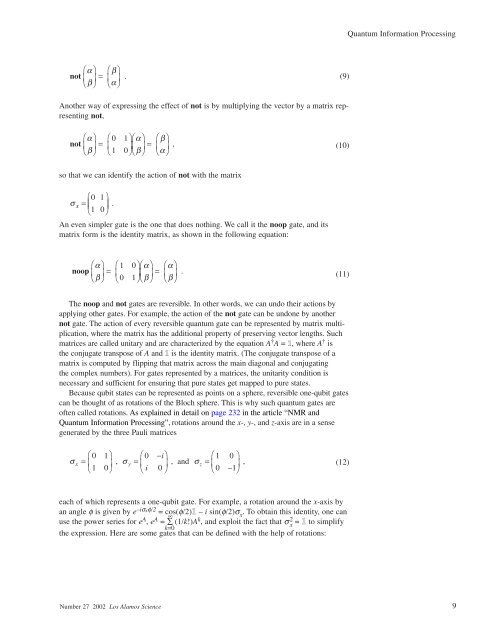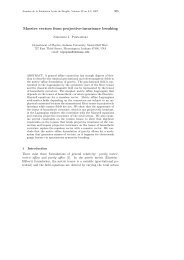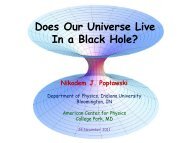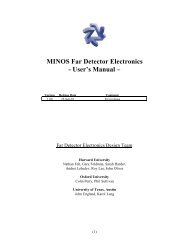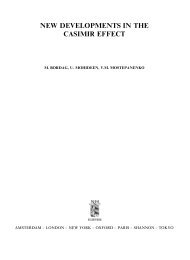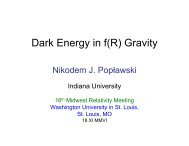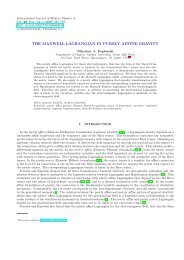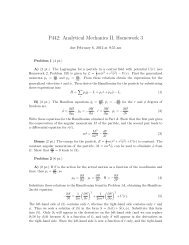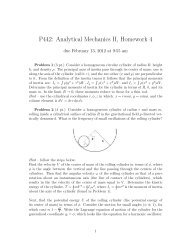Quantum Information Processing
Quantum Information Processing
Quantum Information Processing
You also want an ePaper? Increase the reach of your titles
YUMPU automatically turns print PDFs into web optimized ePapers that Google loves.
not α ⎛ ⎞ ⎛β⎞<br />
⎜ ⎟ = ⎜ ⎟ .<br />
⎝β⎠<br />
⎝α⎠<br />
Another way of expressing the effect of not is by multiplying the vector by a matrix representing<br />
not,<br />
not α ⎛ ⎞ ⎛ 0 1⎞⎛α⎞<br />
⎛β⎞<br />
⎜ ⎟ = ⎜ ⎟⎜<br />
⎟ = ⎜ ⎟ ,<br />
⎝β⎠<br />
⎝ 1 0⎠⎝β⎠<br />
⎝α⎠<br />
so that we can identify the action of not with the matrix<br />
σ x = ⎛0<br />
1⎞<br />
⎜ ⎟<br />
⎝1<br />
0 ⎠<br />
.<br />
An even simpler gate is the one that does nothing. We call it the noop gate, and its<br />
matrix form is the identity matrix, as shown in the following equation:<br />
noop α ⎛ ⎞ ⎛ 1 0⎞⎛α⎞<br />
⎛α⎞<br />
⎜ ⎟ = ⎜ ⎟⎜<br />
⎟ = ⎜ ⎟ .<br />
⎝β⎠<br />
⎝ 0 1⎠⎝β⎠<br />
⎝β⎠<br />
The noop and not gates are reversible. In other words, we can undo their actions by<br />
applying other gates. For example, the action of the not gate can be undone by another<br />
not gate. The action of every reversible quantum gate can be represented by matrix multiplication,<br />
where the matrix has the additional property of preserving vector lengths. Such<br />
matrices are called unitary and are characterized by the equation A † A = 1, where A † is<br />
the conjugate transpose of A and 1 is the identity matrix. (The conjugate transpose of a<br />
matrix is computed by flipping that matrix across the main diagonal and conjugating<br />
the complex numbers). For gates represented by a matrices, the unitarity condition is<br />
necessary and sufficient for ensuring that pure states get mapped to pure states.<br />
Because qubit states can be represented as points on a sphere, reversible one-qubit gates<br />
can be thought of as rotations of the Bloch sphere. This is why such quantum gates are<br />
often called rotations. As explained in detail on page 232 in the article “NMR and<br />
<strong>Quantum</strong> <strong>Information</strong> <strong>Processing</strong>”, rotations around the x-, y-, and z-axis are in a sense<br />
generated by the three Pauli matrices<br />
i<br />
σx = σy σz<br />
i<br />
⎛ 0 1⎞<br />
⎛ 0 − ⎞<br />
⎛ 1 0 ⎞<br />
⎜ ⎟ , = ⎜ ⎟ , and = ⎜ ⎟ ,<br />
⎝ 1 0⎠<br />
⎝ 0 ⎠<br />
⎝ 0 −1⎠<br />
each of which represents a one-qubit gate. For example, a rotation around the x-axis by<br />
an angle φ is given by e –iσxφ/2 = cos(φ/2)1 – i sin(φ/2)σx . To obtain this identity, one can<br />
use the power series for eA , eA ∞<br />
= ∑ (1/k!)Ak , and exploit the fact that σ2 x = 1 to simplify<br />
k=0<br />
the expression. Here are some gates that can be defined with the help of rotations:<br />
Number 27 2002 Los Alamos Science 9<br />
(9)<br />
(10)<br />
(11)<br />
(12)<br />
<strong>Quantum</strong> <strong>Information</strong> <strong>Processing</strong>


